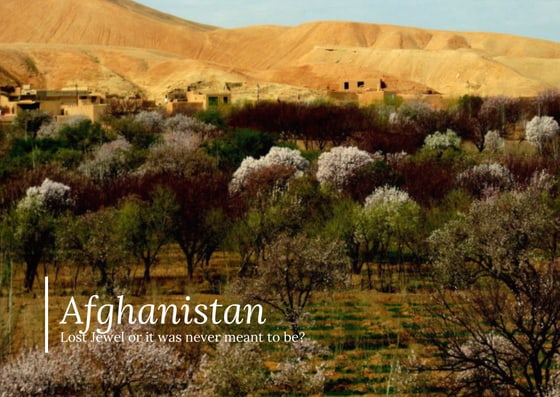Afghanistan: A Lost Jewel or Never Meant to Be?

Whenever we think of Afghanistan the thoughts that come to mind are of the Taliban and that girl with the beautiful eyes who graced the cover of National Geographic one time. We think of a country tortured by decades of war and of women hidden away whose right to freedom had been robbed.
Although it might seem that the country has been living a permanent state of war since the dawn of time, in the past Afghanistan had the potential to be a pretty modern and forward thinking place. One of Internet’s favourite “you-won’t-believe-it’s-real” photographs is one that depicts a group of Afghan girls in front of a university, studying and – gasp – wearing mini-skirts and that 1970s’ extra high coiffure (if you haven’t, go look it up, it’s totally worth the fuss). But how come the country did not fulfil the promise behind those students?
Afghanistan was recognised as a sovereign nation at the beginning of the 1920s; soon after, King Amanullah Khan followed with this plan to modernise the country and introduced several reforms, including making elementary education compulsory for all people – the constitution of 1923 guaranteed the right to free education. Of course not many people were over the moon with these changes, and he was forced to abdicate. The next king, his cousin, switched the reforms (perhaps a little to forward to some) in favour of a more gradual approach to modernisation. Unfortunately, he was assassinated a few years later.
With that Mohammed ZahirShahis crowned king, and he ruled from 1933 to 1973; during that time, he governed with the assistance of Prime Ministers. They managed not only to not be involved in WW II but also benefited from the rivalry between USA and URSS – as both countries vied for Afghanistan’s support they built motorways, airports, and other major infrastructure.
King Zahir Shah’s reign ended when former PM Daoud Khan launched a coup and became president; a few years later the Saur Revolution broke and the People’s Democratic Party of Afghanistan (a communist party) took control. The socialist agenda of the party was stark clear: modernise and secularise (i.e., become non-religious) the country, declare the equality of genders and introduce women into politics. While that seem like a good idea, the way that the PDPA decided to carry it on was not. You see, they were trying to push drastic changes and were very harsh about it.
Well, here is where our tale gets very ugly, very fast: some people – especially the very religious folk at the countryside weren’t keen on those changes imposed by the government; the regimen, then,had an incredibly violent response to it, which led to yet another civil war. Only this time the soviets were involved, because of the party. And because the soviets were involved, so were the USA. The aftermath of this was over one million dead (mostly civilians) and other 6 million refugees who fled the country.
The soviets withdrew in 1989 (because of international pressure over the number of deaths), but the wars continued. President Mohammad Najibullah tried to put a halt to them, but was unsuccessful. Because of the chaotic situation the government couldn’t establish any working departments or police units; Afghanistan was being governed by local commands. Cue more death and insecurity.
In 1996 the Taliban seized control of Kabul and instituted the Islamic Emirate of Afghanistan. A rigorous religious group, they forced the strictest form of sharia law on the population. Their rules were so restrictive that human rights agencies describe their actions as violently forcing people into house arrest.
When they refused to comply with the USA after the attacks of September 2001 a coalition between American, British, and opposition group Northern Alliance was formed to take the Taliban down. More than a decade later, the war still goes on, but the government (established with foreign help) was able to rebuild some structures and work on improving healthcare, education and economy.
Hindered by war and the Taliban’s actions, Afghanistan is now one of the poorest and underdeveloped countries. Could those people who smiled so brightly for a photo in 1970 ever predict such dire future? Could any of us?
